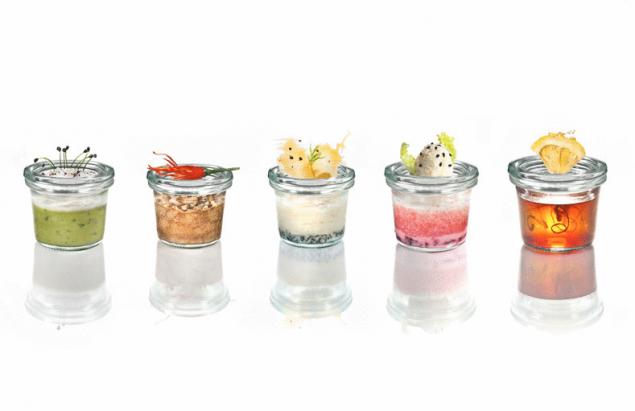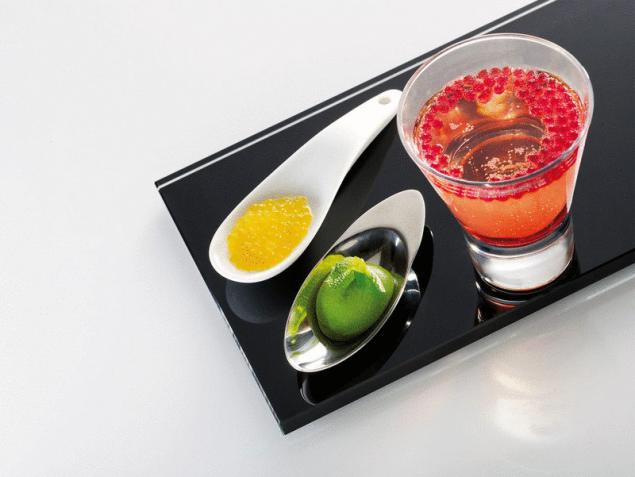Agar-agar, a miracle from the sea bottom
 Bashny.Net
Bashny.Net
Yesterday's exotic becomes today's commonplace. The device, about which we recently talked breathy – blenders, bread makers, crock pots and other yogurtnitsy – have become the norm. You see, ten years, and a device for the su-of view, too, is no surprise. New products come into our lives, perhaps even more than new technology. Agar-agar – in the avant-garde: someone heard this name just recently, someone actually confronted him for the first time, but soon talking all about it, you'll see.

Scientifically speaking, agar-agar is a gelling agent of vegetable origin that is obtained from red and brown seaweeds by extraction, which is, in fact, a vegetable substitute for gelatin. We have agar-agar, and gelatins, usually sold in powder or plates. At the same time in Southeast Asia, where agar comes from, and which is commonly used instead of gelatin, it is found in the form of sticks, threads, jelly cubes, and other exotic forms.
In short, we kind of figured that, technically, agar-agar, he agar – gelatin alternative, and currently less available. However, agar has a number of advantages over gelatin, which many of them prefer it:
Agar has completely vegetable origin, so that it can be freely used in vegetarian food or while fasting. Gelatin, unlike agar, is produced from the connective tissue of animals – and I will not describe this process in detail, to protect the most susceptible readers.

From the first paragraph logically follows the second: the gelatin has a faint taste of the meat, while agar-agar has no taste, so in the preparation of desserts you can use it quite fearlessly.
Gelling properties of agar is stronger than gelatin, as a consequence, this jelly freezes faster, and the agar it requires less.
The agar-agar is 80% fiber, making it perfectly removes toxins from the body and improves liver function, is widely used in diets.
Agar has a higher melting point than gelatin: it melts when heated to 85-95 degrees, freezes at a temperature of 35-40 degrees, and then jelly made with agar, not melt on the table and can even be served hot. The gel that forms agar, thermoablation: heated to 85 degrees, it again becomes a jelly when cooled.
Cake “bird's milk” was the first cake in the USSR, the formulation of which was patented. The author of the cake, confectioner Moscow restaurant "Prague" Vladimir Guralnik, long fought on the final recipe: could not make a soufflé, which will have a rather delicate texture. Finally, after six months of searching Guralnick and his colleagues-pastry chefs found a replacement for gelatin, which is allowed to “bird's milk”, which is remembered and loved by many. As we all know that the secret ingredient, at the time very exotic, was agar-agar.
Agar in our confectionery industry is used still, and, moreover, very active. If you are studying a package of chocolates, souffles, marshmallows, pastilles and other sweets, reach for a dietary Supplement, E406, don't be afraid of it: this is it, harmless and even useful agar-agar.
Typically, agar-agar is used in accordance with the recipe, but if you decide to experiment, here's an approximate guide for the preparation of jelly with agar:
1 serving
— 1 tsp of agar
— 250 ml of fluid
Pour the agar-agar with water or other liquid, stir and bring to a boil. Boil for a few minutes, stirring, and remove from heat. If necessary, add other ingredients, pour into the future of the game in the forms and let cool until firm. In the case that the liquid from which it is supposed to cook the jelly, it is undesirable to expose to heat, you can cook the agar with a small amount of water then mix it with the liquid (but be quick and decisive, so that the temperature of the mixture did not fall to critical values before you have time to stir everything).
I hope we have convinced you that agar-agar is among the things to try in this life. Create, invent, try and share recipes.
источник:dgficc.com
Source: /users/1077

Scientifically speaking, agar-agar is a gelling agent of vegetable origin that is obtained from red and brown seaweeds by extraction, which is, in fact, a vegetable substitute for gelatin. We have agar-agar, and gelatins, usually sold in powder or plates. At the same time in Southeast Asia, where agar comes from, and which is commonly used instead of gelatin, it is found in the form of sticks, threads, jelly cubes, and other exotic forms.
In short, we kind of figured that, technically, agar-agar, he agar – gelatin alternative, and currently less available. However, agar has a number of advantages over gelatin, which many of them prefer it:
Agar has completely vegetable origin, so that it can be freely used in vegetarian food or while fasting. Gelatin, unlike agar, is produced from the connective tissue of animals – and I will not describe this process in detail, to protect the most susceptible readers.

From the first paragraph logically follows the second: the gelatin has a faint taste of the meat, while agar-agar has no taste, so in the preparation of desserts you can use it quite fearlessly.
Gelling properties of agar is stronger than gelatin, as a consequence, this jelly freezes faster, and the agar it requires less.
The agar-agar is 80% fiber, making it perfectly removes toxins from the body and improves liver function, is widely used in diets.
Agar has a higher melting point than gelatin: it melts when heated to 85-95 degrees, freezes at a temperature of 35-40 degrees, and then jelly made with agar, not melt on the table and can even be served hot. The gel that forms agar, thermoablation: heated to 85 degrees, it again becomes a jelly when cooled.
Cake “bird's milk” was the first cake in the USSR, the formulation of which was patented. The author of the cake, confectioner Moscow restaurant "Prague" Vladimir Guralnik, long fought on the final recipe: could not make a soufflé, which will have a rather delicate texture. Finally, after six months of searching Guralnick and his colleagues-pastry chefs found a replacement for gelatin, which is allowed to “bird's milk”, which is remembered and loved by many. As we all know that the secret ingredient, at the time very exotic, was agar-agar.
Agar in our confectionery industry is used still, and, moreover, very active. If you are studying a package of chocolates, souffles, marshmallows, pastilles and other sweets, reach for a dietary Supplement, E406, don't be afraid of it: this is it, harmless and even useful agar-agar.
Typically, agar-agar is used in accordance with the recipe, but if you decide to experiment, here's an approximate guide for the preparation of jelly with agar:
1 serving
— 1 tsp of agar
— 250 ml of fluid
Pour the agar-agar with water or other liquid, stir and bring to a boil. Boil for a few minutes, stirring, and remove from heat. If necessary, add other ingredients, pour into the future of the game in the forms and let cool until firm. In the case that the liquid from which it is supposed to cook the jelly, it is undesirable to expose to heat, you can cook the agar with a small amount of water then mix it with the liquid (but be quick and decisive, so that the temperature of the mixture did not fall to critical values before you have time to stir everything).
I hope we have convinced you that agar-agar is among the things to try in this life. Create, invent, try and share recipes.
источник:dgficc.com
Source: /users/1077
Tags
See also
Each of these 5 products robs You of vitality
The impact of food on the mind
Why tomato juice is the best seller among airline passengers
Top 10 cooking tips that you need to know
Prepare homemade kvass from rye bread
Leo Babauta: What to replace harmful foods in your diet
Whose grandmother to cook?
Seaweed will to do "healthy" chocolate

















